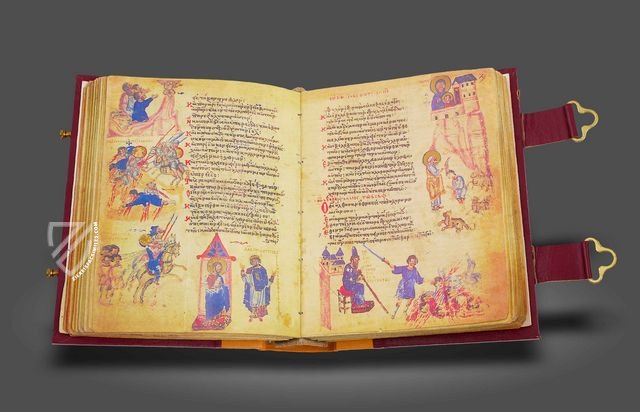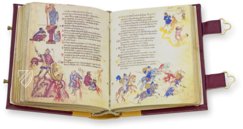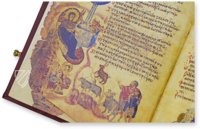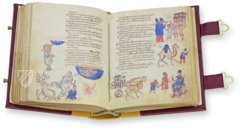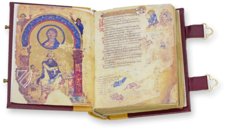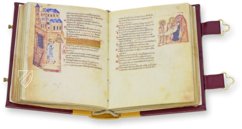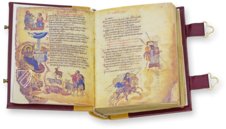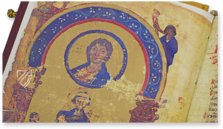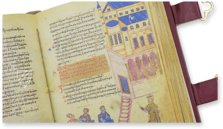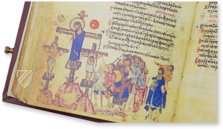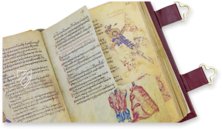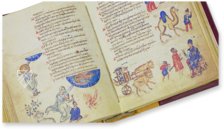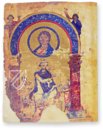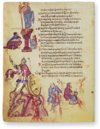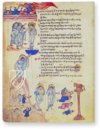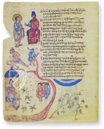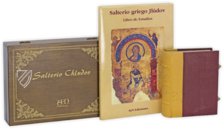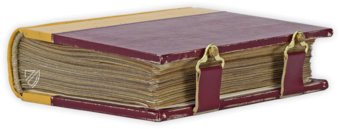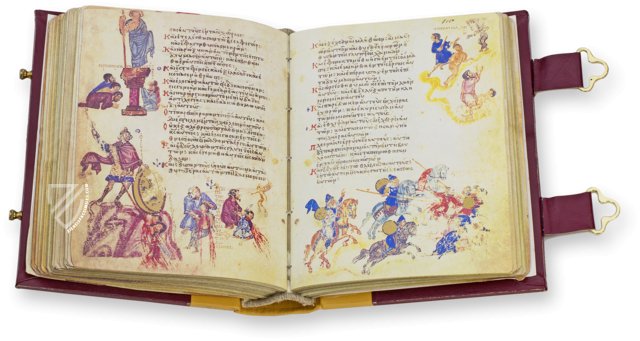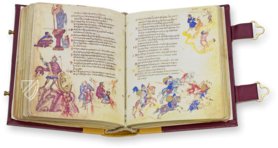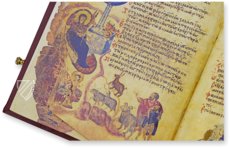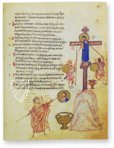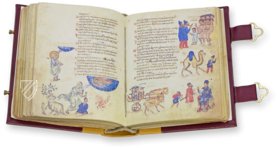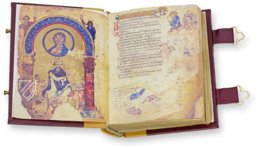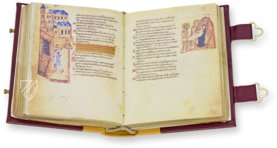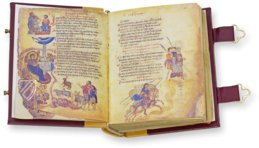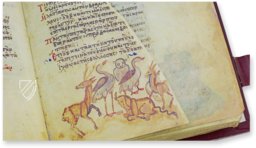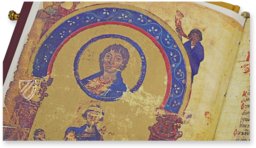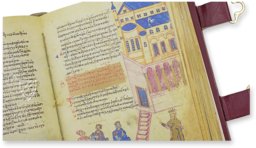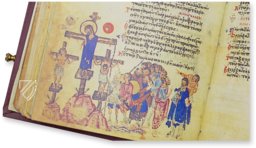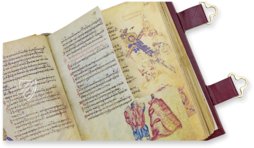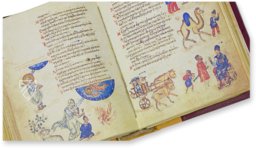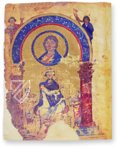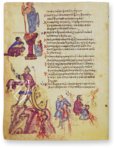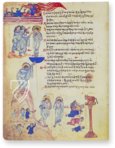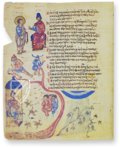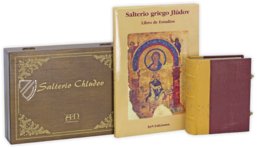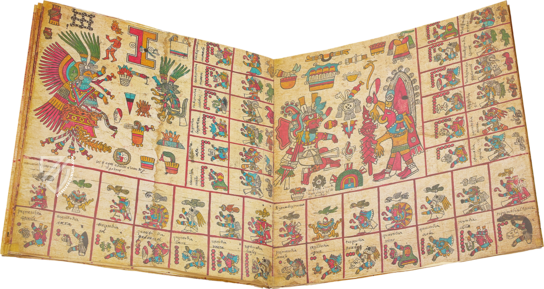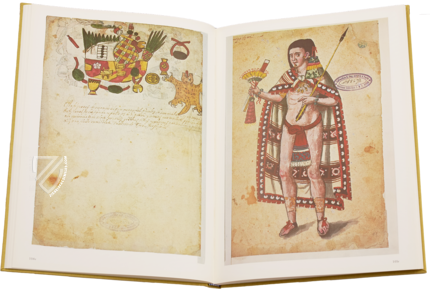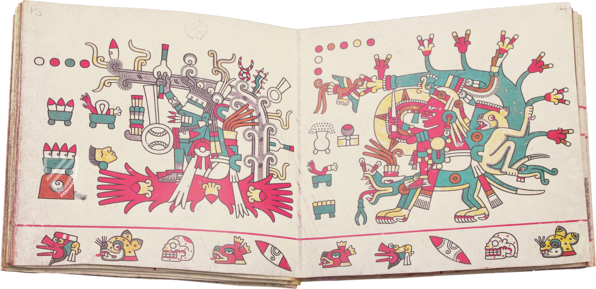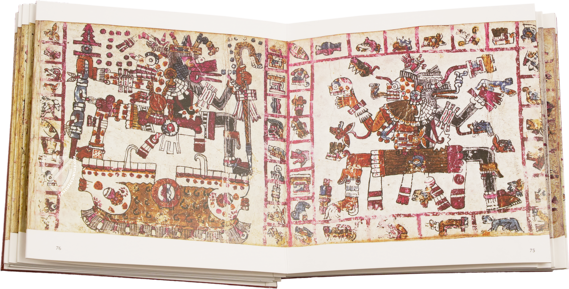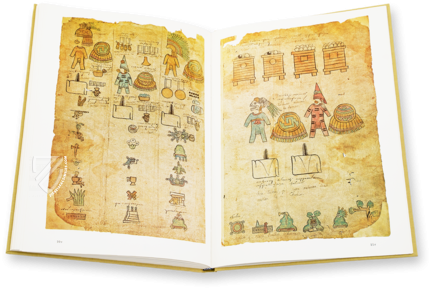Chludov Psalter
(3,000€ - 7,000€)
Between 829 and 837, an illuminated manuscript was made in Constantinople by anonymous illuminators that completely revolutionized the medium of books at that time. The so-called Chludov Psalter, which takes its modern name from its last owner, Alexei Chludov, is an incomparable masterpiece of Byzantine illumination. A part of the work concerns itself with the iconoclastic struggle within the Byzantine Empire, which raged throughout the 9th century and was of tremendous political and religious significance. The countless marginal illuminations are remarkable not only for their breathtakingly bold colors and the small arrows that connect the texts to the pictorial works, but especially for one particular depiction: for the first time in the history of the book, a miniature shows a caricature stylizing the conflict. Thus, the richly illuminated Psalter is a significant testimony to the controversy over iconoclasm in the 9th century.
Chludov Psalter
Over the millennia, the State and Church have used the power of images to assert their status, teach their doctrine, and to generate belief and devotion. It was for this same reason that countless works of art have been wiped out in times of conflict: buildings razed, statues smashed, and pictures burned. Serious outbreaks of iconoclasm – the intentional destruction of images – have repeatedly occurred throughout the course of history. The so-called Chludov Psalter originates from the time of the iconoclastic controversy within the Byzantine Empire during the first half of the 9th century. The unusually polemic style of the work verifies the passion of the strife between the iconoclasts and the iconodules, those representatives of the veneration of images. This is a unique liturgical work that is adorned with 209 truly revolutionary images.
An Incomparable Literary Creation
The Chludov Psalter is the oldest of the three remaining illuminated psalters that were made in the Byzantine Empire sometime in the middle of the 9th century. Part of the Psalter discusses the Byzantine Iconoclasm and thereby employs a unique device, which has never before been used in a liturgical book. The anonymous illuminators used a caricature in order to stylize the political and religious conflict. The person caricatured was the last iconoclastic Patriarch of Constantinople, John VII Grammatikos. A miniature in the psalter illustrates Psalm 69:21, “They also gave me gall for my food, and for my thirst they gave me vinegar to drink.” In the background, the Crucifixion of Jesus Christ at Golgotha is depicted. A soldier reaches Christ with a sponge soaked in vinegar on a pole. In the foreground a depiction of the Patriarch is found, who is erasing an image of Christ with a similar sponge. John Grammatikos is caricatured, both here and on other pages, with crazy hair that sticks out in all directions in order to make him appear laughable to the elegant and refined Byzantines.
The History of a Historically Significant Masterpiece
Research by the Russian historian and expert in Byzantine Art History, Nikodim Kondakow asserts that the Psalter was made in the Monastery of Stoudios in Constantinople. Other academics are of the opinion that the liturgical answers cited in the text would only have been given in the Hagia Sophia, and that the psalter was made in the imperial workshops of Constantinople in the year 843, shortly after the iconodules came back into power. After its creation, it was stored at the Holy Mount Athos, until it was brought to Moscow by the Russian Slavicist in 1847. There it was acquired by the Old Belief seller and art collector Aleksey Ivanovich Khludov, after whom the psalter takes its present title. The psalter was bequeathed along with other parts of his collection to the Nikolai Monastery and has been stored since 1917 in the State Historical Museum in Moscow.
A Revolutionary Picture Program
The astounding miniatures and frame embellishments of the psalter are not only exceptional because of their high-quality design and wide variety of colors. Simultaneously, they are the first pictorial depictions in an illuminated manuscript – worldwide – that were additionally furnished with textual explanations. An additional novelty consists of small arrows, that point from the text to the illustrations. These arrows are meant to indicate what lines correspond to what illustrations. The content of the miniature is not limited to canonical Christian subjects. The frames of the manuscript depict the historical personalities during the time of the Byzantine Iconoclasm, and the miniatures mirror the disputes occurring within society during that epoch. This illumination represents are truly unique and incomparable picture program.
Codicology
- Alternative Titles
- Khludov Psalter
Chludow-Psalter
Salterio Chludov
Psalterio Chludov
Salterio griego Jlúdov
Salterio Khludov - Size / Format
- 338 pages / 19.5 × 15.0 cm
- Origin
- Turkey
- Date
- 829–837
- Epochs
- Style
- Genre
- Language
- Script
- Greek majuscule
- Illustrations
- 209 illuminations surrounding the text
- Content
- Psalms in the arrangement of the Septuagint, with liturgical responses as they would have been sung in the Hagia Sophia
- Previous Owners
- Monastery of Great Lavra on Mount Athos
Monastery of the Holy Trinity on the island of Halki
Aleksey Khludov (1818-82)
Nikolsky Old Believer Monastery
Chludov Psalter
Moses Receives the Ten Commandments
According to Exodus, Moses went up to Mount Sinai three months after the escape from Egypt to receive the Ten Commandments, a cornerstone of the Abrahamic religions. Wearing a golden halo, Moses is depicted humbly receiving the document with his head bowed from the hand of God. Meanwhile, the Israelites at the foot of the mountain have fallen into wickedness: some are depicted dancing and playing music at the base of Mount Sinai while others bow down before the false idol of a calf.
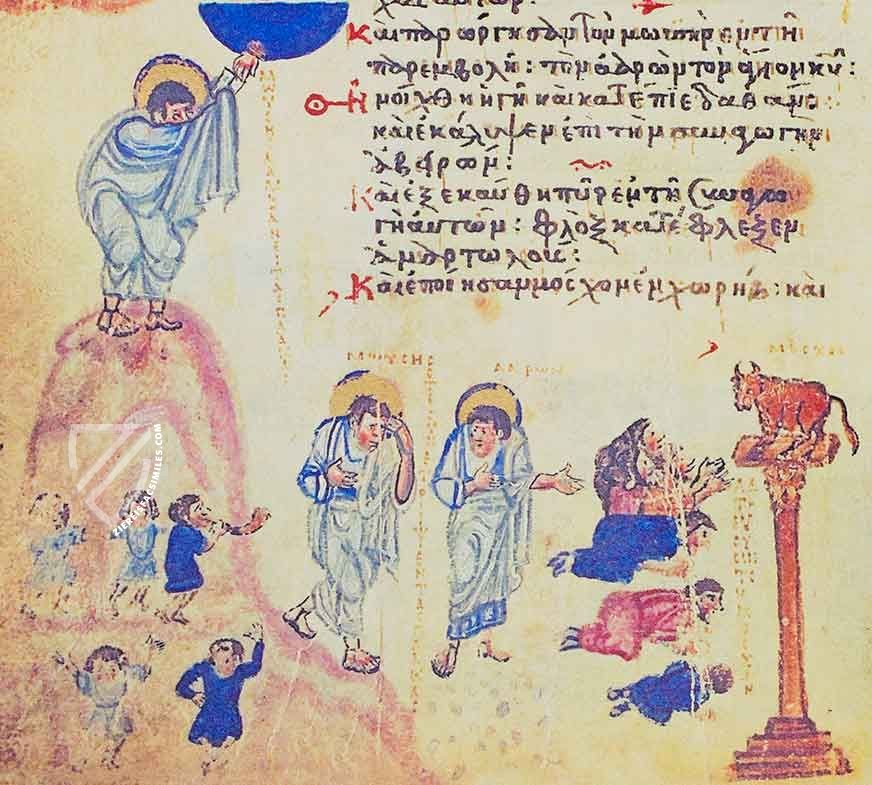
Chludov Psalter
The Iconoclasts and the Crucifixion
This is an incomparable masterpiece of Byzantine illumination. It is also one of the only texts to deal with and challenge the Byzantine Iconoclasm, which sought to strictly enforce the Commandment: “Thou shalt not make unto thee any graven image.”
In the miniature at hand, the last iconoclastic Patriarch of Constantinople, John VII Grammatikos is caricatured with crazy hair that sticks out in all directions in order to make him appear laughable to the elegant and refined Byzantines. He is shown erasing an image of Jesus in direct comparison with the Roman soldiers stabbing Christ Crucified with a spear. Containers appear under each image of Christ, one catches his blood while the other holds the paint with which his image is whitewashed.
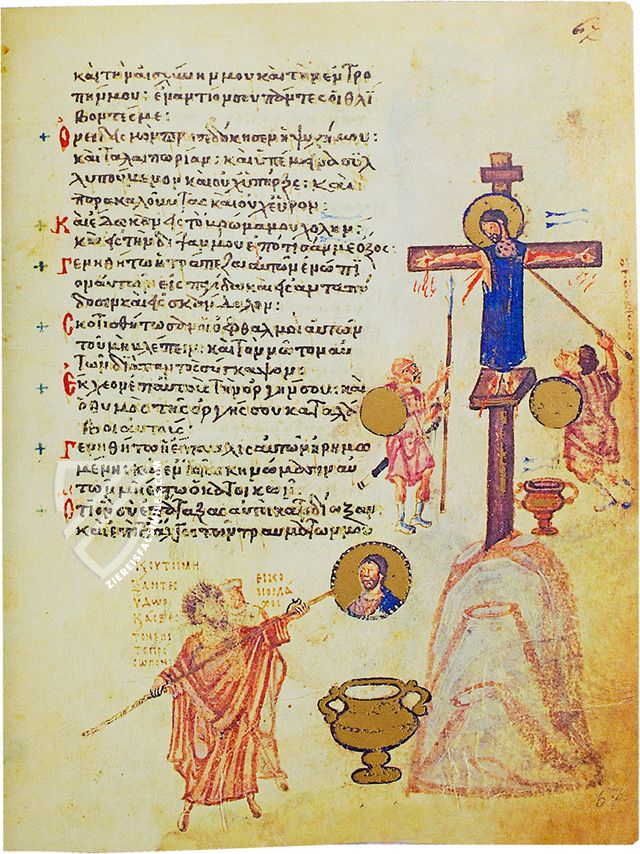
#1 Salterio griego Jlúdov
Language: Spanish
(3,000€ - 7,000€)
- Treatises / Secular Books
- Apocalypses / Beatus
- Astronomy / Astrology
- Bestiaries
- Bibles / Gospels
- Chronicles / History / Law
- Geography / Maps
- Saints' Lives
- Islam / Oriental
- Judaism / Hebrew
- Single Leaf Collections
- Leonardo da Vinci
- Literature / Poetry
- Liturgical Manuscripts
- Medicine / Botany / Alchemy
- Music
- Mythology / Prophecies
- Psalters
- Other Religious Books
- Games / Hunting
- Private Devotion Books
- Other Genres
- Afghanistan
- Armenia
- Austria
- Belgium
- Belize
- Bosnia and Herzegovina
- China
- Colombia
- Costa Rica
- Croatia
- Cyprus
- Czech Republic
- Denmark
- Egypt
- El Salvador
- Ethiopia
- France
- Germany
- Greece
- Guatemala
- Honduras
- Hungary
- India
- Iran
- Iraq
- Israel
- Italy
- Japan
- Jordan
- Kazakhstan
- Kyrgyzstan
- Lebanon
- Liechtenstein
- Luxembourg
- Mexico
- Morocco
- Netherlands
- Palestine
- Panama
- Peru
- Poland
- Portugal
- Romania
- Russia
- Serbia
- Spain
- Sri Lanka
- Sweden
- Switzerland
- Syria
- Tajikistan
- Turkey
- Turkmenistan
- Ukraine
- United Kingdom
- United States
- Uzbekistan
- Vatican City
- A. Oosthoek, van Holkema & Warendorf
- Aboca Museum
- Ajuntament de Valencia
- Akademie Verlag
- Akademische Druck- u. Verlagsanstalt (ADEVA)
- Aldo Ausilio Editore - Bottega d’Erasmo
- Alecto Historical Editions
- Alkuin Verlag
- Almqvist & Wiksell
- Amilcare Pizzi
- Andreas & Andreas Verlagsbuchhandlung
- Archa 90
- Archiv Verlag
- Archivi Edizioni
- Arnold Verlag
- ARS
- Ars Magna
- ArtCodex
- AyN Ediciones
- Azimuth Editions
- Badenia Verlag
- Bärenreiter-Verlag
- Belser Verlag
- Belser Verlag / WK Wertkontor
- Benziger Verlag
- Bernardinum Wydawnictwo
- BiblioGemma
- Biblioteca Apostolica Vaticana (Vaticanstadt, Vaticanstadt)
- Bibliotheca Palatina Faksimile Verlag
- Bibliotheca Rara
- Boydell & Brewer
- Bramante Edizioni
- Bredius Genootschap
- Brepols Publishers
- British Library
- C. Weckesser
- Caixa Catalunya
- Canesi
- CAPSA, Ars Scriptoria
- Caratzas Brothers, Publishers
- Carus Verlag
- Casamassima Libri
- Centrum Cartographie Verlag GmbH
- Chavane Verlag
- Christian Brandstätter Verlag
- Circulo Cientifico
- Club Bibliófilo Versol
- Club du Livre
- CM Editores
- Collegium Graphicum
- Collezione Apocrifa Da Vinci
- Comissão Nacional para as Comemorações dos Descobrimentos Portugueses
- Coron Verlag
- Corvina
- CTHS
- D. S. Brewer
- Damon
- De Agostini/UTET
- De Nederlandsche Boekhandel
- De Schutter
- Deuschle & Stemmle
- Deutscher Verlag für Kunstwissenschaft
- DIAMM
- Droz
- E. Schreiber Graphische Kunstanstalten
- Ediciones Boreal
- Ediciones Grial
- Ediclube
- Edições Inapa
- Edilan
- Editalia
- Edition Deuschle
- Edition Georg Popp
- Edition Leipzig
- Edition Libri Illustri
- Editiones Reales Sitios S. L.
- Éditions de l'Oiseau Lyre
- Editions Medicina Rara
- Editorial Casariego
- Editorial Mintzoa
- Editrice Antenore
- Editrice Velar
- Edizioni Edison
- Egeria, S.L.
- Eikon Editores
- Electa
- Emery Walker Limited
- Enciclopèdia Catalana
- Eos-Verlag
- Ephesus Publishing
- Ernst Battenberg
- Eugrammia Press
- Extraordinary Editions
- Fackelverlag
- Facsimila Art & Edition
- Facsimile Editions Ltd.
- Facsimilia Art & Edition Ebert KG
- Faksimile Verlag
- Feuermann Verlag
- Folger Shakespeare Library
- Franco Cosimo Panini Editore
- Friedrich Wittig Verlag
- Fundación Hullera Vasco-Leonesa
- G. Braziller
- Gabriele Mazzotta Editore
- Gebr. Mann Verlag
- Gesellschaft für graphische Industrie
- Getty Research Institute
- Giovanni Domenico de Rossi
- Giunti Editore
- Graffiti
- Grafica European Center of Fine Arts
- Guido Pressler
- Guillermo Blazquez
- Gustav Kiepenheuer
- H. N. Abrams
- Harrassowitz
- Harvard University Press
- Helikon
- Hendrickson Publishers
- Henning Oppermann
- Herder Verlag
- Hes & De Graaf Publishers
- Hoepli
- Holbein-Verlag
- Houghton Library
- Hugo Schmidt Verlag
- Idion Verlag
- Il Bulino, edizioni d'arte
- ILte
- Imago
- Insel Verlag
- Insel-Verlag Anton Kippenberger
- Instituto de Estudios Altoaragoneses
- Instituto Nacional de Antropología e Historia
- Introligatornia Budnik Jerzy
- Istituto dell'Enciclopedia Italiana - Treccani
- Istituto Ellenico di Studi Bizantini e Postbizantini
- Istituto Geografico De Agostini
- Istituto Poligrafico e Zecca dello Stato
- Italarte Art Establishments
- Jan Thorbecke Verlag
- Johnson Reprint Corporation
- Josef Stocker
- Josef Stocker-Schmid
- Jugoslavija
- Karl W. Hiersemann
- Kasper Straube
- Kaydeda Ediciones
- Kindler Verlag / Coron Verlag
- Kodansha International Ltd.
- Konrad Kölbl Verlag
- Kurt Wolff Verlag
- La Liberia dello Stato
- La Linea Editrice
- La Meta Editore
- Lambert Schneider
- Landeskreditbank Baden-Württemberg
- Leo S. Olschki
- Les Incunables
- Liber Artis
- Library of Congress
- Libreria Musicale Italiana
- Lichtdruck
- Lito Immagine Editore
- Lumen Artis
- Lund Humphries
- M. Moleiro Editor
- Maison des Sciences de l'homme et de la société de Poitiers
- Manuscriptum
- Martinus Nijhoff
- Maruzen-Yushodo Co. Ltd.
- MASA
- Massada Publishers
- McGraw-Hill
- Metropolitan Museum of Art
- Militos
- Millennium Liber
- Müller & Schindler
- Nahar - Stavit
- Nahar and Steimatzky
- National Library of Wales
- Neri Pozza
- Nova Charta
- Oceanum Verlag
- Odeon
- Orbis Mediaevalis
- Orbis Pictus
- Österreichische Staatsdruckerei
- Oxford University Press
- Pageant Books
- Parzellers Buchverlag
- Patrimonio Ediciones
- Pattloch Verlag
- PIAF
- Pieper Verlag
- Plon-Nourrit et cie
- Poligrafiche Bolis
- Presses Universitaires de Strasbourg
- Prestel Verlag
- Princeton University Press
- Prisma Verlag
- Priuli & Verlucca, editori
- Pro Sport Verlag
- Propyläen Verlag
- Pytheas Books
- Quaternio Verlag Luzern
- Reales Sitios
- Recht-Verlag
- Reichert Verlag
- Reichsdruckerei
- Reprint Verlag
- Riehn & Reusch
- Roberto Vattori Editore
- Rosenkilde and Bagger
- Roxburghe Club
- Salerno Editrice
- Saltellus Press
- Sandoz
- Sarajevo Svjetlost
- Schöck ArtPrint Kft.
- Schulsinger Brothers
- Scolar Press
- Scrinium
- Scripta Maneant
- Scriptorium
- Shazar
- Siloé, arte y bibliofilia
- SISMEL - Edizioni del Galluzzo
- Sociedad Mexicana de Antropología
- Société des Bibliophiles & Iconophiles de Belgique
- Soncin Publishing
- Sorli Ediciones
- Stainer and Bell
- Studer
- Styria Verlag
- Sumptibus Pragopress
- Szegedi Tudomànyegyetem
- Taberna Libraria
- Tarshish Books
- Taschen
- Tempus Libri
- Testimonio Compañía Editorial
- Thames and Hudson
- The Clear Vue Publishing Partnership Limited
- The Facsimile Codex
- The Folio Society
- The Marquess of Normanby
- The Richard III and Yorkist History Trust
- Tip.Le.Co
- TouchArt
- TREC Publishing House
- TRI Publishing Co.
- Trident Editore
- Tuliba Collection
- Typis Regiae Officinae Polygraphicae
- Union Verlag Berlin
- Universidad de Granada
- University of California Press
- University of Chicago Press
- Urs Graf
- Vallecchi
- Van Wijnen
- VCH, Acta Humaniora
- VDI Verlag
- VEB Deutscher Verlag für Musik
- Verlag Anton Pustet / Andreas Verlag
- Verlag Bibliophile Drucke Josef Stocker
- Verlag der Münchner Drucke
- Verlag für Regionalgeschichte
- Verlag Styria
- Vicent Garcia Editores
- W. Turnowski Ltd.
- W. Turnowsky
- Waanders Printers
- Wiener Mechitharisten-Congregation (Wien, Österreich)
- Wissenschaftliche Buchgesellschaft
- Wissenschaftliche Verlagsgesellschaft
- Wydawnictwo Dolnoslaskie
- Xuntanza Editorial
- Zakład Narodowy
- Zollikofer AG

